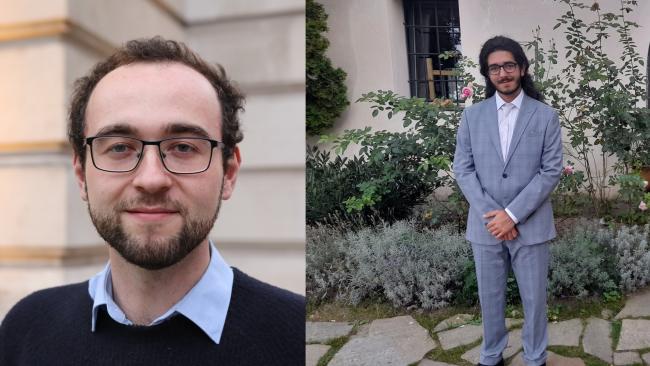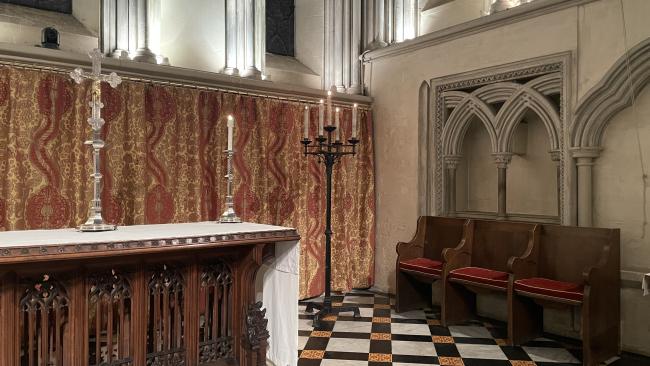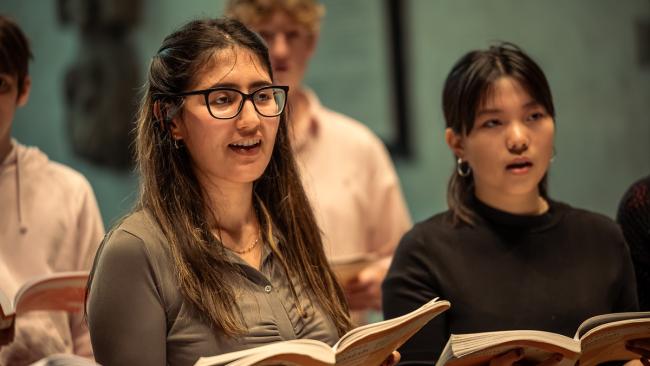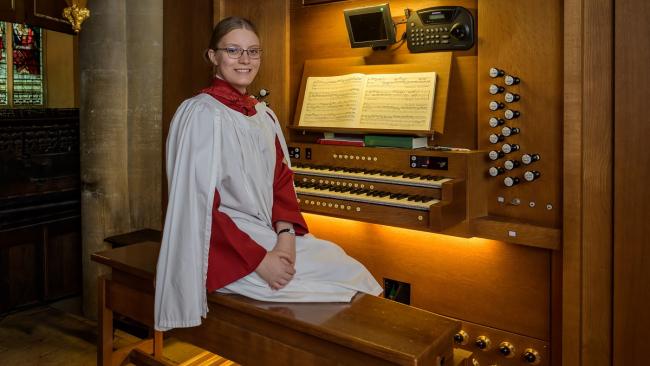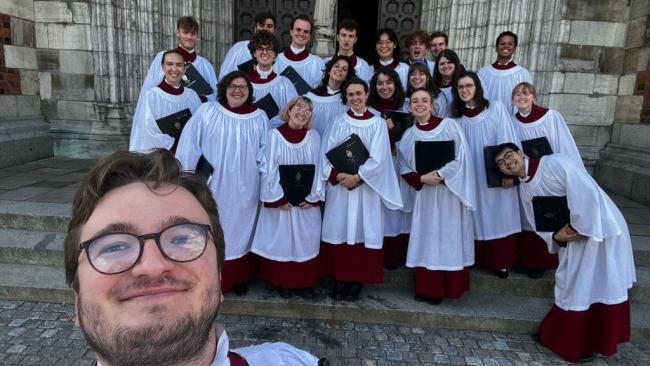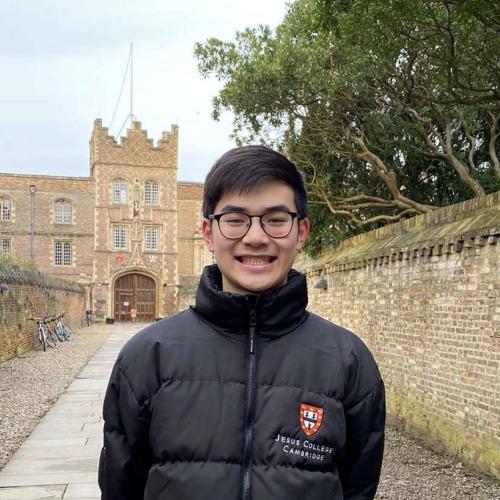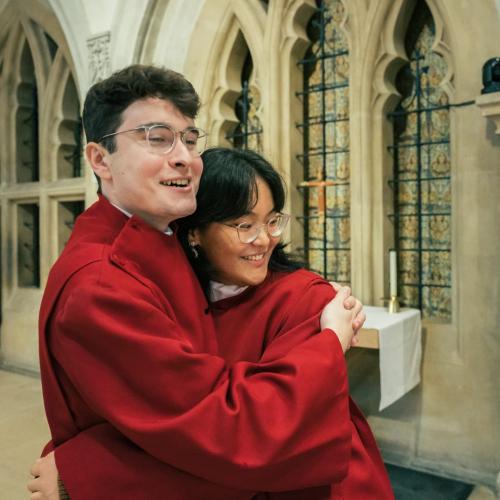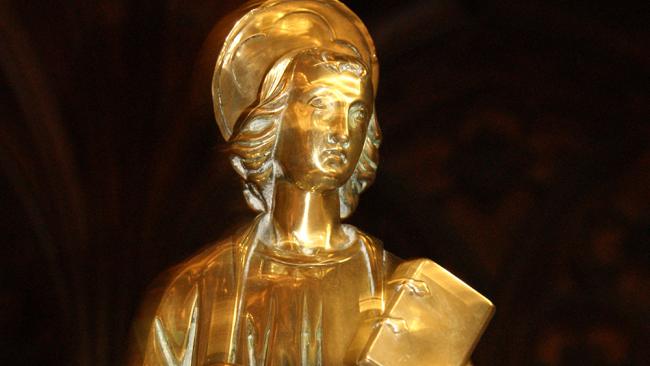
History of the Chapel
The stones of Jesus College Chapel tell stories of fire, reform, war, revival — and the traditions of a prayerful community.
- The convent church (12th to 14th centuries)
- The College Chapel (late 15th to early 16th centuries)
- Reform and counter reform (mid 16th to early 17th centuries)
- Civil War and Restoration (mid to late 17th century)
- Redesigning the Chapel (18th century)
- Gothic revival (19th century)
- Living traditions (20th century to present)
The convent church (12th to 14th centuries)
Jesus College Chapel is the oldest in Cambridge, and unique in that it was not originally designed as a college chapel. Instead, it existed for 350 years before the foundation of the College, and for half a century before the creation of the University.
It was originally a large Norman church dedicated to St Mary, which served the 12th century Benedictine convent of St Mary and St Radegund.
The church took about a century to build; begun in 1157 it was completed around 1245. At that time it was the largest church in Cambridge, about 58 metres in length and with similar proportions to a cathedral. It was built in the form of a cross, with aisles to the north and south of chancel and nave, and it had a high pitched roof with a belfry or steeple which was visible for miles around.
It served as the church of the parish of St Radegund which grew up around the convent — at that time a semi rural area located just outside the city of Cambridge.
In 1277 the belfry collapsed, and again in 1313. In 1376, fire destroyed much of the surrounding convent but largely spared the church itself, causing only some light damage to the tower.
The College Chapel (late 15th to early 16th centuries)
When the College was founded in 1496 by Bishop John Alcock, extensive building work was needed to adapt the former convent church for its new use. Parts of the church were demolished and what was left was drastically modified. It was then reconsecrated in the Name of Jesus.
While the church had previously been dedicated to St Mary, there was very probably an altar dedicated to the Name of Jesus in the people's part of the church.
Alcock was an architect as well as a bishop and designed many of these alterations himself. The changes were intended to create a Chapel which was a more suitable size for a small community of scholars than the old church.
The beginning of this work on the new Chapel was overseen by his friend and Fellow of the College, William Plombe, in 1497-98. After Alcock’s death in 1500, the work was continued by some other friends: Dr William Chubbes, the first master of the College, and architects Sir John Rysley and Sir Reginald Bray.
The chancel chapels and the aisles of the nave of the church were pulled down and the cloisters were enlarged. The new cloisters were enclosed by walls that contained four windows in the Perpendicular Gothic style. The dilapidated belfry was taken down and the high pitched roof was replaced by a flat roof with an oak ceiling. The lancet windows in the eastern wall were replaced by a plain Perpendicular style window.
Two thirds of what had been the nave of the church were replaced by College rooms, which subsequently became part of the eastern wing of the Master’s Lodge. The chapels on the north and south sides of the choir were pulled down and the northern aisles became part of the cloister; the original columns are still embedded in the wall. The screen which had divided the congregation at the west end of the crossing was replaced by a more open screen at the east side.
The 13th century arches which had divided the aisles from the nave were either pulled down to make way for the college rooms or were blocked off with stone and concealed with plaster. The four arches in the chancel and the two arches in the north transept were all filled in and covered over, and in the new walls Perpendicular windows were placed.
In the south transept, the eastern arch was also filled in and covered over, two Perpendicular windows were inserted in the eastern and western walls, and a very large Perpendicular window was inserted in the southern wall.
Reform and counter reform (mid 16th to early 17th centuries)
In 1549, during the period of Protestant iconoclasm under Edward VI, six altars in the Chapel and some images in the Master’s Lodge were destroyed.
During the Catholic restoration that followed in the reign of Mary I, Dr John Fuller was appointed Master in 1557 and he restored the old ritual and ornaments in the Chapel.
During the reign of Elizabeth I, the College fellowship became Protestant again in its sympathies, although not Puritan, and the elaborate services in the Chapel were simplified.
James I was a frequent visitor to Cambridge and to Jesus College, worshipping in the College Chapel when he visited the city. In 1617, James’ Chancellor of the Exchequer and Jesus College alumnus Sir Fulke Greville planned to fill in the nave of the Chapel and create new rooms to cater for the continually expanding membership of the College. Fortunately, this scheme was never carried out.
In 1634, under the Mastership of Dr Richard Sterne, a new organ was bought and an organist was employed to play it. Two years later new furniture, plate, and candlesticks for the altar were purchased in line with the High Church reforms of Archbishop Laud.
At this time the College was known as a stronghold of the High Church in the University and Chapel services were renowned for ‘good music, elaborate solemnity and attractive decency’.
Civil War and Restoration (mid to late 17th century)
With the coming of the Civil War, the College was drawn in to the dispute between the King and Parliament.
In 1641, the House of Commons issued an order to all Colleges ‘to displace the Communion table from the east end of their chapels, to take away the rails and level the chancel, and to remove crucifixes, tapers, and basins from the Communion table’. The Fellows were forced to put away all the new furnishings that they had recently bought for the Chapel.
Next Charles I called on the Fellows to raise a loan of £100 and to send pieces of the College plate to his camp in York. Part of the plate was seized by Cromwell’s men before it could be transported out of Cambridge, but most of it was successfully taken to York.
For this the Master, Richard Sterne, and the former Master, William Beale, were arrested by Cromwell during a service in the Chapel and taken to the Tower of London. The Fellows took apart the organ in the Chapel and hid the pieces. What was left of the College plate is said to have been buried in the orchard.
Puritan iconoclast William Dowsing was commissioned by Parliament to purge the churches and chapels of Cambridge of their ‘monuments of superstition’. At Christmas in 1643 he visited the College and ‘digg’d up the Steps there and brake down Superstitions of Saints and Angels, 120 at the least’.
The following year all but two of the Fellows were ejected from the College and Richard Sterne was deposed from the Mastership. In 1659 a bell was purchased for the belfry.
At the Restoration, the interior of the Chapel was repaired and restored to its former beauty by successive new Masters, Dr John Pearson and Dr Joseph Beaumont, between 1660 and 1663. The organ was rebuilt and reinstated in the Chapel.
In 1676 the Chapel was paved with black and white marble, and some time between 1660 and 1680 a gallery was built in the chancel, facing towards the altar. The remains of a Classical entrance which is still visible on the south wall may well date from this time.
Redesigning the Chapel (18th century)
By contrast with the previous period, the early 18th century was an uneventful time in the history of the College and very few additions or even repairs to the Chapel seem to have been made.
However, between 1762 and 1765 the piers and arches of the cloisters were demolished and rebuilt to designs by James Essex. The use of the organ in the Chapel was also discontinued during this period and the organ was dismantled and given to the parish of All Saints. Its casework may now be seen in Little Bardfield church in Essex.
In the 1780s the Perpendicular east window in the chancel was rebuilt, and between 1789 and 1792 a major restoration of the Chapel was undertaken in order to bring it into accord with the popular Classical ideal in architecture. In the chancel, 16th century stalls and some sections of the old carved woodwork from the pulpit and the screen were removed. A partition wall of plaster was built above the gallery and the entrance of the choir to block off the eastern arch of the tower, and adorned with Ionic pillars.
The oak roof of the chancel was now hidden by a new flat plaster ceiling and another plaster ceiling was built across the open square of the tower to hide the gallery. About 13 years later, the external walls of the Chapel were overlaid with cement and the battlements and the mouldings of the windows were similarly repaired.
Gothic revival (19th century)
The 19th century saw major new restoration work on the Chapel, inspired by the new spirit of the Gothic revival. It was carried out between 1846 and 1849, and largely reversed the earlier repairs.
The leaders of this new restoration were the Rev'd John Gibson, then Dean of the College, and the Rev'd Osmond Fisher, a notable Victorian geologist. Gibson was responsible for issuing an appeal to old members of the College and was appointed treasurer of the restoration fund.
Their aim was to restore the ritual as well as the architecture of the Chapel, including the restoration of music to the Chapel services through the purchase of an organ and the reinstatement of the choir. The new organ was designed and purchased in 1849 by John Sutton, who served as the Chapel organist, instituted and ran a choir school in the College, and published a collection of anthems.
Under the direction of Anthony Salvin, who had recently undertaken a controversial restoration of the Round Church, the 18th century partition wall in the chancel arch was removed in 1846, along with the gallery on its eastern side. A new combined organ chamber and vestry was built on the eastern side of the northern transept. The two arches which opened into the choir were rediscovered and unblocked, together with the two arches which opened upon the north transept below the gallery.
The reopening of the arches of the northern chapel seriously weakened the north eastern pier of the tower and the removal of its upper floor was considered. However, the tower was eventually strengthened by filling the two arches below the gallery with heavy tracery, uniting those in the chancel with a low solid screen of stone and building a heavy buttress in the vestry. The upper level of the tower was also strengthened with heavy iron bolts.
These repairs were carried out on the advice of the architect Augustus Pugin (famous for his work on the Houses of Parliament) who was a close friend of John Sutton and who had come to Cambridge to take the measurements for the organ chamber. On Sutton’s recommendation, the College decided to employ Pugin to direct the restoration of the Chapel.
Pugin removed both the 18th century plaster ceiling and Alcock’s low-pitched roof, which he replaced by a high pitched roof in a 13th century style. He also rebuilt the choir stalls and the eastern wall and removed Alcock’s Perpendicular east window, replacing it with three tall lancet windows; archaeological evidence had been unearthed in the course of the restoration that showed this was the original design. Pugin installed stained-glass windows of his own design in 1850 and the other windows were later glazed in the same style between 1850 and 1858.
In the north transept, the Norman windows that were embedded in the north wall were rediscovered. They were preserved as recessed arches and the whole wall was restored. New stalls and a new pavement were also supplied for the chancel. The newly purchased organ was installed in the organ chamber and on All Saints’ Day 1849 the Chapel was reopened with a full choral service.
In 1862, cracks began to appear in the arches and piers of the tower. Further repairs were carried out between 1864 and 1867 by George F. Bodley, who was also working on All Saints’ Church in Jesus Lane, opposite the entrance to the College. The tower was refaced and restored, a solid buttress was built for its support in the south east corner of the Master’s garden, and a wrought iron rod was placed above the choir screen.
Decorations for the panelled ceilings of the nave and the tower were designed by William Morris and painted under his direction in 1867. Between 1873 and 1877 the windows in the nave and transepts of the Chapel were glazed by Morris and Company from designs by Edward Burne-Jones and Ford Madox Brown. A larger and more powerful organ was purchased to complement Sutton’s organ in 1887 and was installed in a new gallery at the west end of the nave.
By the end of the 19th century the Chapel had attained its present proportions and appearance. The Norman original, together with Early English, Decorated and Perpendicular elements, Essex’s 18th century cloisters, and Pugin’s and Burne-Jones’ 19th century restorations combine to form a remarkable building.
Living traditions (20th century to present)
Compulsory chapel attendance was abolished at Jesus College in the early 20th century, and the organ and gallery were removed from the west end of the nave (the gallery may still be seen over the road at Westcott House). The organist and schoolmaster was replaced by an organ scholar in 1919, and since then many distinguished church musicians have trained at the College.
Although the Chapel's fixtures and fittings have remained much as they were at the outbreak of the First World War, several restorations have revealed more of the building. Work uncovered on the north wall of the nave appears to be William Morris’s demonstration of what the walls would look like if decorated. It seems that the Fellows preferred a simpler finish as the sample patch remained covered in whitewash for over 130 years.
Thanks to a generous gift, in 2006 a new organ by Kuhn of Switzerland was installed to replace the Mander of 1969. Worship services continue to take place at the Chapel daily during term time, in a living tradition of prayer stretching back to the 12th century.
Further reading
- Collis, J. (2007) The Chapel and English Religion. Jesus: The Life of a Cambridge College, ed. P. Glazebrook, Cambridge: Granta Editions, pp. 82-9.
- Morgan, Iris and Gerda (1914) The Stones and Story of Jesus Chapel Cambridge, Cambridge: Bowes & Bowes.
- Ray, N. (1994) Cambridge Architecture: A Concise Guide, Cambridge University Press.
- Sikes, J. and Jones, F, (1959) The colleges and halls: Jesus. A History of the County of Cambridge and the Isle of Ely: Volume 3, the City and University of Cambridge, ed, J.P.C. Roach, London, pp. 421-8.
- Webster, H. and Howard, P. (2000) Cambridge: An Architectural Guide Part 4, London: Ellipsis.
